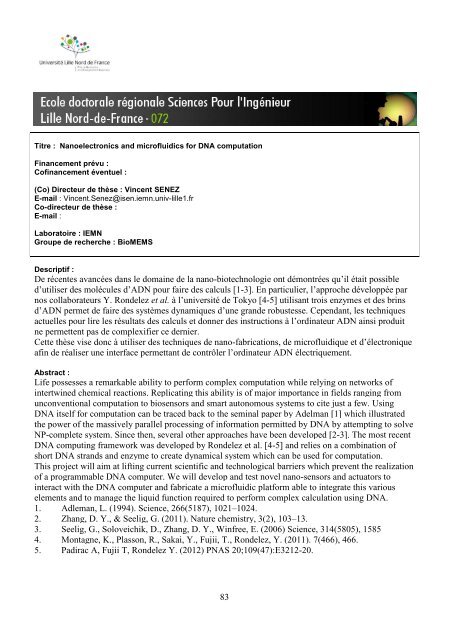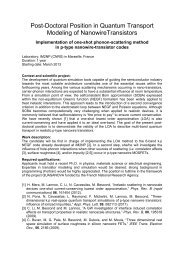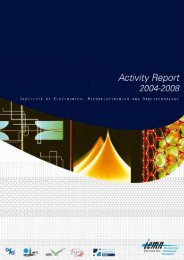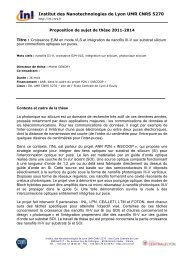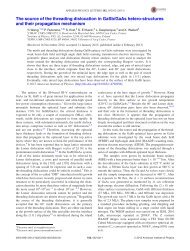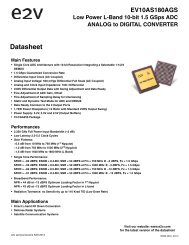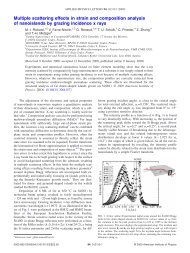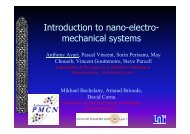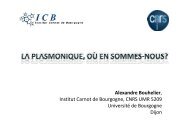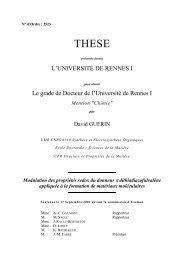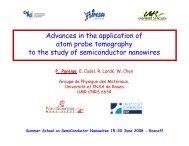Sujet de Doctorats 2013 - IEMN
Sujet de Doctorats 2013 - IEMN
Sujet de Doctorats 2013 - IEMN
- No tags were found...
You also want an ePaper? Increase the reach of your titles
YUMPU automatically turns print PDFs into web optimized ePapers that Google loves.
Titre : Nanoelectronics and microfluidics for DNA computationFinancement prévu :Cofinancement éventuel :(Co) Directeur <strong>de</strong> thèse : Vincent SENEZE-mail : Vincent.Senez@isen.iemn.univ-lille1.frCo-directeur <strong>de</strong> thèse :E-mail :Laboratoire : <strong>IEMN</strong>Groupe <strong>de</strong> recherche : BioMEMSDescriptif :De récentes avancées dans le domaine <strong>de</strong> la nano-biotechnologie ont démontrées qu’il était possibled’utiliser <strong>de</strong>s molécules d’ADN pour faire <strong>de</strong>s calculs [1-3]. En particulier, l’approche développée parnos collaborateurs Y. Ron<strong>de</strong>lez et al. à l’université <strong>de</strong> Tokyo [4-5] utilisant trois enzymes et <strong>de</strong>s brinsd’ADN permet <strong>de</strong> faire <strong>de</strong>s systèmes dynamiques d’une gran<strong>de</strong> robustesse. Cependant, les techniquesactuelles pour lire les résultats <strong>de</strong>s calculs et donner <strong>de</strong>s instructions à l’ordinateur ADN ainsi produitne permettent pas <strong>de</strong> complexifier ce <strong>de</strong>rnier.Cette thèse vise donc à utiliser <strong>de</strong>s techniques <strong>de</strong> nano-fabrications, <strong>de</strong> microfluidique et d’électroniqueafin <strong>de</strong> réaliser une interface permettant <strong>de</strong> contrôler l’ordinateur ADN électriquement.Abstract :Life possesses a remarkable ability to perform complex computation while relying on networks ofintertwined chemical reactions. Replicating this ability is of major importance in fields ranging fromunconventional computation to biosensors and smart autonomous systems to cite just a few. UsingDNA itself for computation can be traced back to the seminal paper by A<strong>de</strong>lman [1] which illustratedthe power of the massively parallel processing of information permitted by DNA by attempting to solveNP-complete system. Since then, several other approaches have been <strong>de</strong>veloped [2-3]. The most recentDNA computing framework was <strong>de</strong>veloped by Ron<strong>de</strong>lez et al. [4-5] and relies on a combination ofshort DNA strands and enzyme to create dynamical system which can be used for computation.This project will aim at lifting current scientific and technological barriers which prevent the realizationof a programmable DNA computer. We will <strong>de</strong>velop and test novel nano-sensors and actuators tointeract with the DNA computer and fabricate a microfluidic platform able to integrate this variouselements and to manage the liquid function required to perform complex calculation using DNA.1. Adleman, L. (1994). Science, 266(5187), 1021–1024.2. Zhang, D. Y., & Seelig, G. (2011). Nature chemistry, 3(2), 103–13.3. Seelig, G., Soloveichik, D., Zhang, D. Y., Winfree, E. (2006) Science, 314(5805), 15854. Montagne, K., Plasson, R., Sakai, Y., Fujii, T., Ron<strong>de</strong>lez, Y. (2011). 7(466), 466.5. Padirac A, Fujii T, Ron<strong>de</strong>lez Y. (2012) PNAS 20;109(47):E3212-20.83


